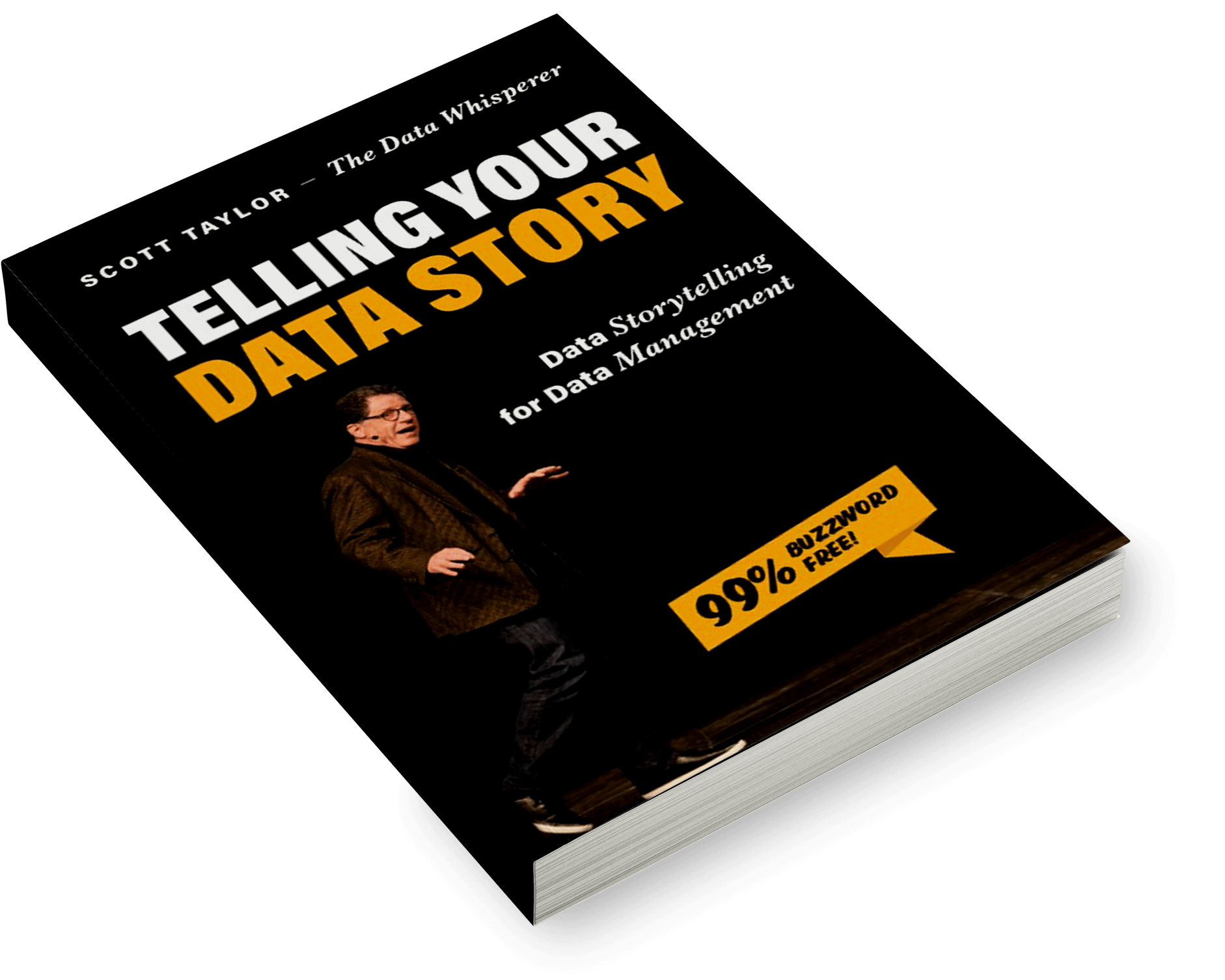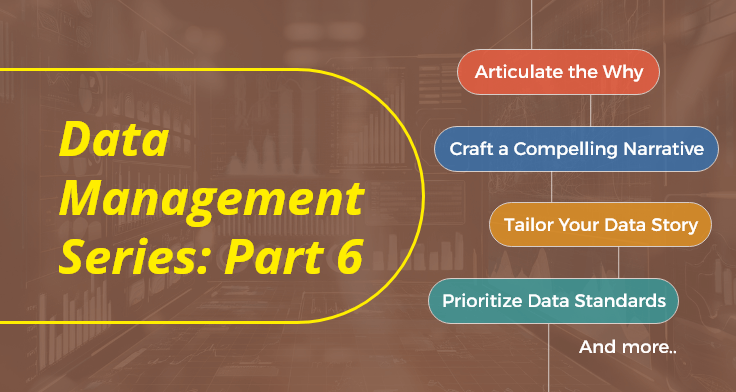To help BRIDGE THE STORY GAP between Data and The Business, we are excited to share excerpts from the book ‘TELLING YOUR DATA STORY – Data Storytelling for Data Management’ by our knowledge partner, Scott Taylor, The Data Whisperer.
Formalize and organize your data story by uncovering your company vision and expose the data challenges that, in many cases, are hidden in plain sight.
Securing executive buy-in is crucial for the success of your data management initiatives. Once executives buy-in, then getting the help of the rest of the organization should be easier. C-Level approval gives the rest of an organization “permission to believe.” You won’t have to spend as much time convincing others.
Here are eight essential tips to effectively prepare and present your data story to executives to secure their buy-in.
1. Tailor Your Data Story
Executives may require one-on-one sessions. Make sure you cover the same topics as all the other sessions but summarize them to an executive level. If your C-level executives have chiefs of staff or other support functions, make sure you take them through the content as well. Seek their guidance on how best to format and deliver your message. You may run into some office politics, such as making sure your boss approves, and their boss and their boss. Of course, it depends on the personality and dynamics of your leadership. But most leaders want to hear about all areas of their business.
2. Expect Interruptions & Manage Time
Be ready for interruptions. C-Level executives are quick to grasp concepts; they are thinking of wide-reaching ramifications. Because of their broad field of view, they may see possibilities that you do not. And yes, they can make connections you can not. Be ready to answer their questions in the moment, especially if it is a one-on-one or small meeting. Give them an abbreviated answer if necessary, to keep your flow going. The worst thing you can do is say, “I am going to cover that later.” There might not be a later. Know how much time you have and stick to it. If executives want a meeting to go on longer, it will. But don’t expect to get more time. Make sure your content would only take up about half of the scheduled meeting. You will want questions and some back and forth.
3. Be Prepared for Success
Prepare for success. Sometimes an executive leader will suddenly ask what you want next. Be ready for that. Your goal is to gain a commitment. Your objective is not to get through all your slides. A little story about CEOs – I have had exposure to more than my share of CEOs, and I always love talking with them. They are smart, aware, and quick to respond. While I was at Nielsen, I had the genuine honor of working directly with our CEO at the time, Dave Calhoun. He is a world-class leader. He was a top protégé of Jack Welsh while at General Electric and is now CEO of Boeing. So, this guy has done and seen it all. I was explaining a concept to him, and he suddenly said, “OK, Scott, what is the one thing I can do for you?” I was uncharacteristically tongue-tied and not at all ready for a corporate genie to grant my wish. I mumbled something like, “Wow, let me think about it.” That was the wrong answer.
I wasn’t ready for success. I vowed I would be next time – if there were ever a next time. I worked with my team to come up with a short, concise answer. As luck would have it, months later, Calhoun asked me the same thing “OK, Scott, what is the one thing I can do for you?” I had my answer ready.
4. Crisp Delivery
Your leader’s style might be different but think of that story. Be ready for success. Have that one thing you need in your mind. Turn it around and offer it up. Your closing can be, “Here is the one thing I need from you.” Don’t make it five or twelve. Keep it simple. Leaders appreciate crisp delivery. It is the best way to get invited back.
5. Articulate Why It Matters
I do not suggest you attempt to convince leadership that improving data management is more critical than any single item already on their corporate priority list. As a solo effort, data management will never become a corporate priority. Nor should it, but here is why that is an opportunity. Having reliable data is a mandatory requirement for most, if not all, corporate priorities. Study the key business initiatives of your organization. Do those objectives have anything to do with increasing market penetration? Operational efficiency? Mitigating risk? Strengthening security? Authenticating identity? Mergers and acquisitions? Data management plays a mission-critical role in all of those. The data management discussion can no longer be relegated to the IT domain; it should be front-and-center in a business strategy and management discussion chaired by at least one top corporate leader and board member.
6. Prepare a Roadmap
For organizations that are not culturally aligned to using existing information, every system or process runs the risk of creating new data sets. Time to success is inversely proportional to the count of systems. To keep a successful implementation on track, clearly identify your stakeholders and attend to them strategically. Produce and manage an implementation roadmap that shows a steady stream of data project accomplishments. Prioritize your efforts carefully. The simple top-down approach, basing priority on expenditures or sales, can prove data management value quickly. Tackle some of your largest relationships in an early phase. Work with those partners who are willing to experiment and test.
7. Prioritize Data Standards
To drive adoption, set organization-wide data standards for collection, delivery, and maintenance. Then enforce consistent compliance with internal standards. Strict and formal governance is needed: Clearly define a strategy for leveraging information and elevate the importance of data across the organization—support for data management will soon follow. Finally, trust in those who guard your data as a hard asset. If data is not valued, investments in its management will not be valued either.
8. Craft a Compelling Narrative
Your story needs to capture the hearts and minds of your business leadership. Certainly, return-on-investment calculations and cost-per-record savings can help those trying to fund one-time cleanup efforts and tactical projects. Data management, however, needs to become a holistic enterprise program. Because everyone benefits, isolating funding can be difficult. With growing pressure on investments to produce quicker and more defined payback, many stakeholders may perceive an individual risk of supporting something for the greater good. Middle management, especially, may consider data management to be a tax or a toll. They might complain that they never see any direct benefit. Therefore, your story must prove why it helps the entire enterprise holistically. Formalize and organize your data story by uncovering your company vision and expose the data challenges that, in many cases, are hidden in plain sight. It is your task to discover them.
A data management program goes well beyond technical requirements. It demands a strategic understanding of the business direction and marketplace dynamics. Business alignment, careful planning around business nomenclature, and agreement across the organization are paramount.
In the seventh and final part of this series, you’ll get some storytelling advice you can’t refuse from Fransis Ford Coppola.

Excerpted with permission from Technics Publications from ‘TELLING YOUR DATA STORY – Data Storytelling for Data Management’ by Scott Taylor, The Data Whisperer & Infocepts Partner.
Recent Blogs

LLMs – Self-Hosting or APIs? The Million Dollar Question
April 16, 2025

Fashion Retail in the Age of AI: Redefining Design and Customer Experience with Data & Intelligence
April 11, 2025

Navigating the Tariff Shock: How AI and Advanced Analytics Fuel Supply Chain Resilience
April 7, 2025

From Data to Decisions: The Evolving Role of Data Science & AI in Supply Chain
March 20, 2025


